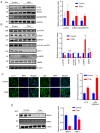Dual targets of lethal apoptosis and protective autophagy in liver cancer with periplocymarin elicit a limited therapeutic effect
- PMID: 36825592
- PMCID: PMC9946806
- DOI: 10.3892/ijo.2023.5492
Dual targets of lethal apoptosis and protective autophagy in liver cancer with periplocymarin elicit a limited therapeutic effect
Abstract
Cardiac glycosides (CGs) are candidate anticancer agents that function by increasing [Ca2+]i to induce apoptotic cell death in several types of cancer cells. However, new findings have shown that the anti‑cancer effects of CGs involve complex cell‑signal transduction mechanisms. Hence, exploring the potential mechanisms of action of CGs may provide insight into their anti‑cancer effects and thus aid in the selection of the appropriate CG. Periplocymarin (PPM), which is a cardiac glycoside, is an active ingredient extracted from Cortex periplocae. The role of PPM was evaluated in HepG2 cells and xenografted nude mice. Cell proliferation, real‑time ATP rate assays, western blotting, cell apoptosis assays, short interfering RNA transfection, the patch clamp technique, electron microscopy, JC‑1 staining, immunofluorescence staining and autophagic flux assays were performed to evaluate the function and regulatory mechanisms of PPM in vitro. The in vivo activity of the PPM was assessed using a mouse xenograft model. The present study demonstrated that PPM synchronously activated lethal apoptosis and protective autophagy in liver cancer, and the initiation of autophagy counteracted the inherent pro‑apoptotic capacity and impaired the anti‑cancer effects. Specifically, PPM exerted a pro‑-apoptotic effect in HepG2 cells and activated macroautophagy by initiation of the AMPK/ULK1 and mTOR signaling pathways. Activation of macroautophagy counteracted the pro‑apoptotic effects of PPM, but when it was combined with an autophagy inhibitor, the anti‑cancer effects of PPM in mice bearing HepG2 xenografts were observed. Collectively, these results indicated that a self‑limiting effect impaired the pro‑apoptotic effects of PPM in liver cancer, but when combined with an autophagy inhibitor, it may serve as a novel therapeutic option for the management of liver cancer.
Keywords: apoptosis; autophagy; cardiac glycosides; liver cancer; periplocymarin.
Conflict of interest statement
The authors declare that they have no competing interests.
Figures







References
-
- Cheng L, Wang C, Ma X, Wang Q, Cheng Y, Wang H, Li Y, Liu Z. Multifunctional upconversion nanoparticles for dual-modal imaging-guided stem cell therapy under remote magnetic control. Advanced Functional Materials. 2013;21:272–280. doi: 10.1002/adfm.201201733. - DOI
MeSH terms
Substances
LinkOut - more resources
Full Text Sources
Medical
Miscellaneous
